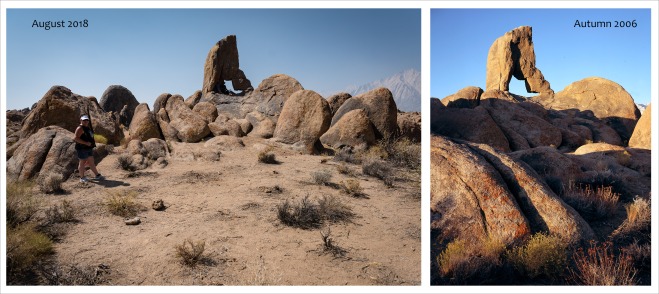I am part of two communities who exhibit behaviors on public lands that I am often angered by and find myself at odds with: climbers and outdoor photographers. I suspect that many have never experienced trailhead or public lands closures caused by improper/unethical/illegal use – I have.
Many climbers trample vegetation at the base of crags and boulders; they leave athletic tape, food wrappers, and the tape from rope ends wherever they fall. The rock and the climb take first priority; concern for vegetation, trampling, wildlife (including ants and all sorts of small vertebrates and invertebrates that we can’t even see), and wildlife habitat is secondary (or doesn’t matter). Sadly, this sort of behavior has now become commonplace in the outdoor photography community. In this Instagram-era, a staggering number of landscapes have now been subject to the onslaught of careless humans and an uncountable number of popular photography locations have been drastically altered by the photographers that use them. It’s wrong, disappointing, and has to end before photographers find themselves locked out of locations that they’ve commonly been able to enjoy. If you think this can’t happen, just have a chat with a member of the MTB (mountain biking) or OHV (Off-Highway Vehicle) communities for their angle.
A little more than a week ago I guided my sister, nephew, and brother-in-law through an Eastern Sierra camping/roadtrip. One of our first stops/camps was Alabama Hills below Mt. Whitney and the High Sierra crest. You Western film buffs and photographers know this place well. What you probably don’t know is that the Alabama Hills Stewardship Group has vastly improved the condition and quality of experience for visitors and photographers over the last dozen years by removing graffiti and rubbish; breaking down numerous fire rings; obliterating excess and illegal roads; and planting native vegetation to rehabilitate the abused. I’ve watched the Hills become cleaner and even more beautiful over the last twelve years. During this period digital photography has exploded – especially night sky and astrophotography – and ironically, I’ve watched its photographic ‘hot spots’ deteriorate at the very same time.
 I took my sister and family to a lesser known arch in the Hills (but still popular with night photographers) and was dismayed by what we walked into: it looked obliterated by grazing cattle (there are no grazing cattle here). Although from different angles, perspectives, and focal lengths, a comparison of the two images will reveal missing, damaged, or dead plants. And I am dumbfounded by this. The other side of this arch does not look like this; it’s not the preferred angle for photographers. This is not from drought, fire, or cattle, and this is not a dense landscape – the shrubs could have been very easily avoided or worked around. Instead, the land before this arch has now become a micro-wasteland.
I took my sister and family to a lesser known arch in the Hills (but still popular with night photographers) and was dismayed by what we walked into: it looked obliterated by grazing cattle (there are no grazing cattle here). Although from different angles, perspectives, and focal lengths, a comparison of the two images will reveal missing, damaged, or dead plants. And I am dumbfounded by this. The other side of this arch does not look like this; it’s not the preferred angle for photographers. This is not from drought, fire, or cattle, and this is not a dense landscape – the shrubs could have been very easily avoided or worked around. Instead, the land before this arch has now become a micro-wasteland.
My sub-teenage nephew learned a few of the following commandments while we were in the field and I’m urging every photographer and non-photographer who uses public lands to please adopt and share these with other photographers, climbers, fishermen/fisherladies, etc. Humans are trashing virtually everything; lest we lose our access, please be the high-road user group that sets the examples others will desire to follow.
The Outdoor Photographers Ten Commandments
1. I don’t own this planet or this particular landscape. I’m a visitor here and my needs and wants are secondary to its primary inhabitants. I’m thankful that I get to share this space with them.
2. I will step around or over EVERY plant I encounter, no matter whether dead or alive.
3. If a plant, boulder, or other natural object is in my composition – no matter what – I will recompose instead of altering or damaging the landscape.
4. I will avoid herd mentality and behavior. I will do my very best to not travel in photographic packs, but when I do, I will be very mindful of my steps and actions as well as those of my fellow photographers.
5. I will not covet the photographs or locations of other photographers. I understand that popularity has led to the ecological decline of many ‘hot spots’ and that great photographs can be found just about anywhere.
6. If I specialize in night photography, I will make sure that I have adequate daylight preparation or proper nighttime illumination so as not trample or destroy ANY vegetation anywhere around me.
7. I will never take anything, leave anything, or alter anything in the pursuit of my photographs.
8. If I can’t make the image I desire without breaching these commandments, I will walk away empty handed.
9. I will educate my fellow photographers and students (if you teach/lead workshops) about the critical importance of field ethics.
10. In the existential scheme of things, me and my photographs don’t really matter. It’s never worth abusing plants or a landscape to make an insignificant photograph.
You are visiting the blog of landscape photographer Michael E. Gordon. For additional photos and information, please visit his website or follow him on Facebook and Instagram.

Pingback: Leave No Trace | Lightscapes Nature Photography Blog
Pingback: The Geography of Hope: The Incompatible Ideals of Wilderness and Industrialized Tourism – MICHAEL E. GORDON PHOTOGRAPHY